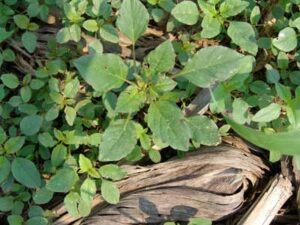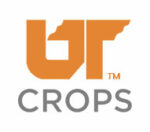LINKS
Pigweed Description, History and Management
Classification and Description:
 Amaranthus is the genus for the pigweed family. The word is derived from the Greek word amarantus which means “everlasting”. Most growers would agree that this is a very accurate description for the pigweeds. Of the 865 members of this family there are 9 pigweeds commonly found as weeds in Tennessee. These 9 weedy pigweeds can be separated into three distinct groups.
Amaranthus is the genus for the pigweed family. The word is derived from the Greek word amarantus which means “everlasting”. Most growers would agree that this is a very accurate description for the pigweeds. Of the 865 members of this family there are 9 pigweeds commonly found as weeds in Tennessee. These 9 weedy pigweeds can be separated into three distinct groups.
The first group includes redroot pigweed (Amaranthus retroflexus), smooth pigweed (Amaranthus hybridus) and slender amaranth (Amaranthus gracilis). These have been the most common pigweeds in Tennessee row crop agriculture for the last 50 years. Redroot pigweed can be found throughout much of Tennessee, but usually is not the dominant pigweed found in cropping systems. Smooth pigweed has been the dominate pigweed in crop production. Slender amaranth can also be a problem in row crop agriculture though not to the extent of smooth pigweed. These three species of pigweeds have similar upright growth habits, are difficult to distinguish in seedling stage, compete very well with most crops, and have both male and female flowers on the same plant.
The second group of pigweeds includes common waterhemp (Amaranthus rudis) and Palmer amaranth (Amaranthus palmeri). They originated in the Midwest and Southwest and are relative newcomers to Tennessee. Tall waterhemp (Amaranthus tuberculatus) is very closely related to common waterhemp and is also a member of this group. Tall waterhemp is considered to be native to the Mississippi river bottom. These three pigweed species have separate male and female plants, have an upright but somewhat branched growth habit and are very competitive with crops. They are a very diverse group and differ widely as to branching and coloration within species. Common and tall waterhemp are very difficult to tell apart from each other and can be found in small numbers primarily in West Tennessee. New genetic research shows that common and tall waterhemp are very similar. Therefore many researchers now have simply lumped them into one species, common waterhemp. Palmer amaranth is closely related to waterhemp and has long been the dominant pigweed in the southwest. It is the most competitive and rapidly growing species of the weedy pigweeds. Over the last few years Palmer amaranth has become one of the most troublesome weed problems in row crops throughout West Tennessee.
The third pigweed group includes spiny amaranth (Amaranthus spinosus), tumble pigweed (Amaranthus albus), and prostrate pigweed (Amaranthus blitoides). These pigweeds are similar in that they are somewhat prostrate, usually have substantial branching, and are not as competitive to row crops as the other weedy pigweeds. Of these spiny amaranth is the most predominant weedy pigweed across the state of Tennessee. It is the only pigweed commonly a problem in both row crops and pastures. Prostrate and tumble pigweed can be found in much of Tennessee but are typically confined to field edges. All of these weeds can cause problems in cropping systems on occasion.
History:
In Tennessee, pigweeds were prevalent in large numbers and were very competitive prior to the widespread use of herbicides in cropping systems. When broadcast applications of soil-applied herbicides were widely used and followed by one or more cultivations in row crops, pigweeds of any type only occasionally escaped control and developed into a real problem for the grower. However, with the reduction in usage of soil-applied and incorporated herbicides designated to control grasses and small-seeded weeds, pigweeds escaped control more often. Sole reliance on postemergence treatments was often not as effective as preemergence or preplant incorporated herbicides for pigweed control. One reason for this is that pigweeds can emerge from March to September in Tennessee. Postemergence treatments that lack residual will only control those emerged pigweeds. Cultivation which had always been a good backup procedure for controlling pigweeds ,has all but ceased and the move toward conservation tillage created a more favorable environment for germination and growth of pigweed species in cropping systems. Moreover, planting dates for row crops, particularly corn, have been pushed up much earlier in the spring. Earlier planting dates have helped increase yields but have also extended the amount of time weed control management must be active. This is primarily due to slower shading by crops under typically cooler growing conditions.
Certain pigweed biotypes have evolved resistance to the triazine and urea herbicides like atrazine, Princep, Cotoran, Direx, etc. These pigweeds resistant to the triazine and urea herbicides though present in Tennessee are not widespread. About a decade ago, several biotypes of common waterhemp and Palmer amaranth developed resistance to Scepter, Staple, Steadfast, Classic, etc. the ALS enzyme inhibiting herbicides. At the time these herbicides were used extensively in soybeans and to a lesser extent in cotton and corn. Today most populations of waterhemp and Palmer amaranth are considered resistant to this class of chemistry. More recently some biotypes of common waterhemp in the Midwest have developed resistance to the diphenyl ether chemistry while a population of Palmer amaranth in the Carolinas has been confirmed with resistant to the dinitroanaline herbicides like Treflan and Prowl.
Management Considerations:
Pigweed control is not an impossible task since there are a number of effective herbicides available. The pigweed species in general can best be managed when a pre-applied herbicide is followed by a post or when a post-applied herbicide is followed by another post-applied that contains some type of residual product to control pigweeds.
Herbicides that are in many premixes such as Dual II Magnum, Cinch, Degree, Harness, Outlook, Fultime and Frontier will provide residual control of pigweed in corn. Atrazine will provide both burndown and residual activity on small pigweed. The plant growth regulator herbicides like Distinct, Clarity and 2,4-D are other options in corn. Callisto is a new post-applied herbicide for corn that has very good activity on pigweed.
In soybeans Dual, Prowl and Spartan will all provide residual control of pigweed. Glyphosate is a very good control option for pigweed postemergence. The diphenyl ethers like Reflex, Blazer and Cobra will also control pigweeds post if they are 4 inches in height or smaller. Treflan is still a very good option in conventional till soybeans.
As with soybeans, glyphosate is the backbone for weed control in cotton. Glyphosate will control pigweeds provided there is thorough spray coverage. However, it does not have residual activity and therefore Cotoran, Caparol, Dual II, Direx and Valor or premixes that contain these products should be considered in order to acquire consistent control.
The spring and summer environment changes daily. Responding to these changes as they occur is key to consistently controlling pigweeds. Soil-applied herbicide performance can be diminished or enhanced depending upon rainfall 5 to 10 days after application. Post-applied herbicide performance can also vary depending upon weather conditions. Long, hot dry spells prior to herbicide application can encourage weeds to develop thicker cuticles making it more difficult for post-applied herbicides to enter the plant. An extra post-applied herbicide application may be needed or a sequential post-applied program may have to be used to control escapes due to one of these poor herbicide x environment interactions. Good weed control is a matter of correctly identifying the weeds and the state the weeds are in (fast growing, stunted etc) before weed management strategies are finalized. Then a sound weed management plan should be made to address the weed problem.
Literature Cited:
Gleason, H. A. and A. Cronquist. 1963. Manual of plants. 280-282.
Horak, M. J., D. E. Peterson, D. J. Chessman, and L. M. Wax. 1994. Pigweed identification: A pictorial guide to the common pigweeds of the Great Plains. Publication S80. Manhattan, KS: Kansas Cooperative Extension Service.
Sauer, J. 1956. Recent migration and evolution of the dioecious amaranths. Evolution 11:11-31.







